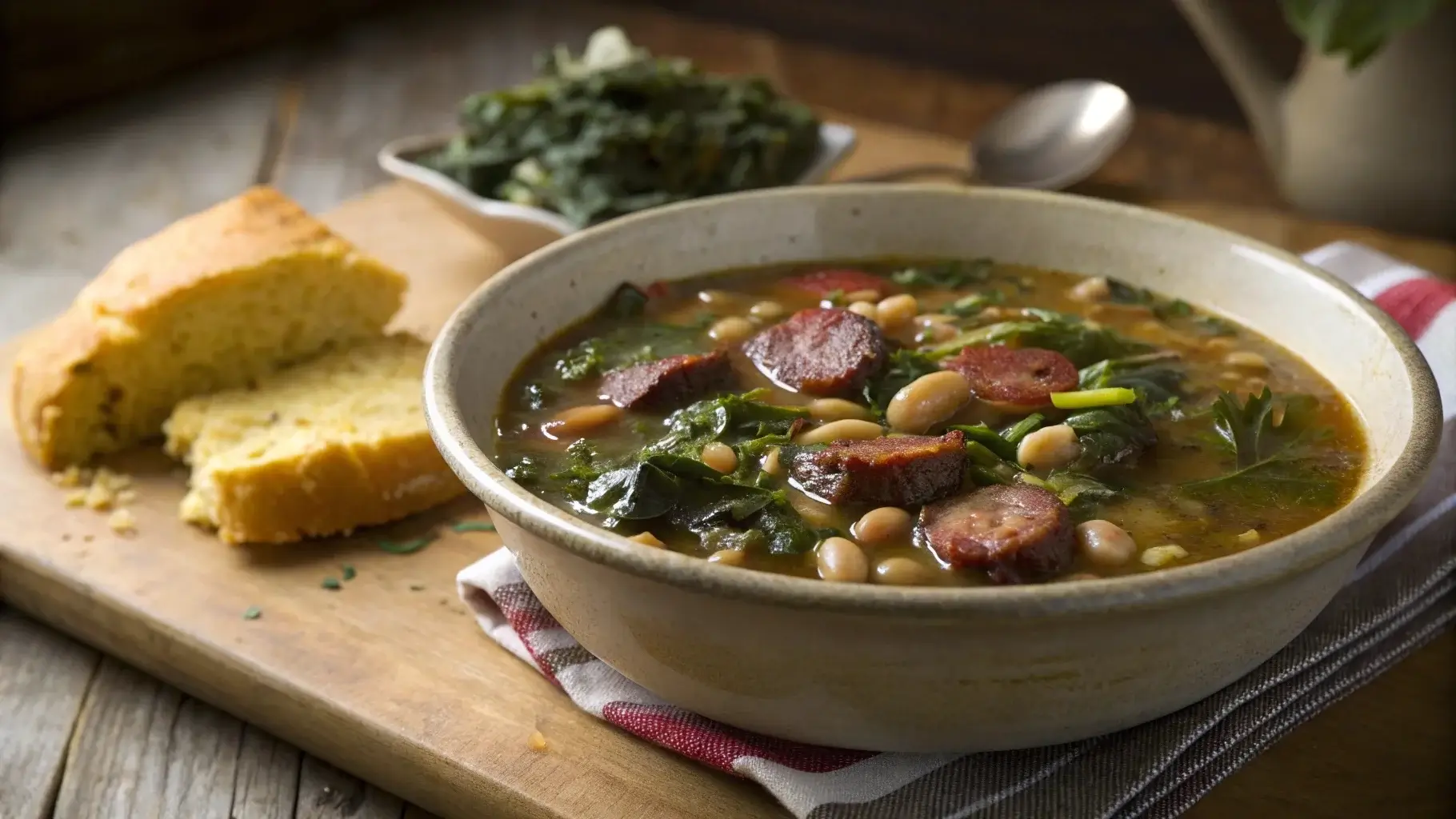There’s nothing quite like a warm, comforting bowl of soup on a chilly evening. And when it comes to Southern comfort food, swamp soup is a must-try. This hearty, flavorful dish is packed with tender greens, smoky sausage, creamy beans, and a rich, savory broth. It’s a one-pot wonder that’s easy to make and perfect for busy weeknights or cozy weekends.
The first time I made swamp soup was on a rainy Sunday afternoon with my husband, Momo. We were craving something warm, filling, and packed with flavor, so we decided to try this Southern classic. I’ll admit, I was a little skeptical at first. Greens and beans in the same soup? Would it be too bitter or too heavy?
But as the soup simmered, our kitchen filled with the mouthwatering aroma of garlic, onions, and smoked beef sausage. The broth thickened, the flavors deepened, and by the time we ladled it into our bowls, we couldn’t wait to dig in. One spoonful in, and we were hooked. The combination of tender greens, creamy beans, and perfectly seasoned broth was simply irresistible.
Now, swamp soup has become a regular in our home, especially on cool evenings when we need something warm and satisfying. Whether you’re a longtime fan or a first-timer like we were, this guide will walk you through everything you need to know to make the perfect bowl of swamp soup.
Table of Contents
Why You Will Love Swamp Soup Recipe
There are countless reasons to fall in love with swamp soup, and once you try it, you’ll see why it’s a household favorite. Whether you’re looking for a quick, hearty meal or something deeply comforting, this soup has you covered.
1. It’s Packed with Flavor
Swamp soup combines smoky sausage, creamy beans, and rich greens, all simmered in a well-seasoned broth. Every spoonful bursts with flavor, making it hard to resist.
2. Easy to Make with Simple Ingredients
One of the best things about this Swamp Soup Recipe Guide is that it doesn’t require fancy ingredients. Most of what you need is probably already in your pantry—beans, broth, pasta, and seasonings. Just a few simple steps, and your soup is ready!
3. Perfect for Meal Prep and Leftovers
If you love cooking once and eating multiple times, swamp soup is perfect for you. It stores well in the fridge and even gets better as the flavors develop. Plus, it’s freezer-friendly, so you can make a big batch and enjoy it later.
4. Budget-Friendly and Nutritious
Swamp soup is an affordable meal that doesn’t sacrifice nutrition. It’s packed with protein from beans and sausage, fiber from greens, and essential vitamins from the broth. It keeps you full without breaking the bank.
5. Completely Customizable
Do you love spicy food? Add some jalapeños. Prefer a creamy texture? Stir in a little coconut milk. Want more protein? Add shredded chicken. You can easily tweak this recipe to fit your taste, making it an excellent addition to your weekly meal rotation.
Nutritional Facts per Serving
| Nutrient | Amount per Serving |
|---|---|
| Calories | 320 kcal |
| Protein | 18g |
| Carbohydrates | 28g |
| Fiber | 7g |
| Fat | 12g |
| Sodium | 780mg |
| Iron | 15% DV |
This nutrition breakdown may vary depending on ingredient substitutions and portion sizes.
Essential Ingredients for Swamp Soup Recipe
A great soup starts with great ingredients. In swamp soup, every component plays a role in creating a hearty, flavorful dish. Here’s a breakdown of the essential ingredients and how each contributes to the perfect bowl of soup.
Greens: The Heart of the Recipe
The deep green color of swamp soup comes from leafy greens, which add a rich, earthy taste and essential nutrients. The best options include:
- Turnip greens – The traditional choice, offering a slightly peppery flavor.
- Collard greens – Milder and slightly more robust in texture.
- Spinach or kale – Softer greens that cook quickly and blend well into the soup.
Beans: Adding Protein and Texture
Beans give the soup a creamy, hearty feel while boosting its protein and fiber content. The most commonly used varieties are:
- Kidney beans – A classic choice with a firm texture.
- Black-eyed peas – Slightly softer and nuttier in flavor.
- Cannellini beans – A mild, buttery bean that blends well with other ingredients.
Protein Choices: A Rich and Smoky Flavor
Traditionally, smoked sausage is used in swamp soup to add depth and a slightly spicy kick. However, you can substitute with:
- Smoked beef sausage – A flavorful option that enhances the broth.
- Turkey sausage – A leaner alternative without sacrificing the smokiness.
- Grilled chicken – A lighter protein option that still adds substance.
Pasta or Rice: Thickening the Soup
To make swamp soup even heartier, a starch like pasta or rice is added. You can use:
- Small pasta like ditalini or elbow macaroni for a chewy texture.
- White or brown rice for a softer, more filling soup.
For a heartier texture, adding small pasta like ditalini works perfectly in swamp soup. If you’re new to using ditalini, check out this Ditalini Pasta Recipe for more ways to incorporate it into your meals.
Seasonings and Broth for the Perfect Balance
The magic of swamp soup lies in its well-balanced seasoning. Here’s what you need:
- Garlic and onions – The flavor base that ties everything together.
- Chicken or vegetable broth – Provides a rich, savory foundation.
- Apple cider vinegar – Adds a slight tang to brighten up the flavors.
- Salt, black pepper, and smoked paprika – The essential spices for depth and warmth.
Complete Ingredient List
| Ingredient | Quantity |
|---|---|
| Smoked beef sausage | 1 lb, sliced |
| Turnip greens | 3 cups, chopped |
| Kidney beans | 1 can (15 oz), drained |
| Black-eyed peas | 1 can (15 oz), drained |
| Ditalini pasta | 1 cup |
| Onion | 1, diced |
| Garlic cloves | 3, minced |
| Chicken broth | 6 cups |
| Apple cider vinegar | 2 tbsp |
| Olive oil | 2 tbsp |
| Smoked paprika | 1 tsp |
| Salt & pepper | To taste |
With these ingredients in hand, you’re ready to bring swamp soup to life. Now, let’s move on to the step-by-step cooking process!
Step-by-Step Cooking Instructions
Now that we’ve covered the ingredients, let’s dive into how to prepare this Swamp Soup Recipe Guide from start to finish.
Step 1: Preparing the Ingredients
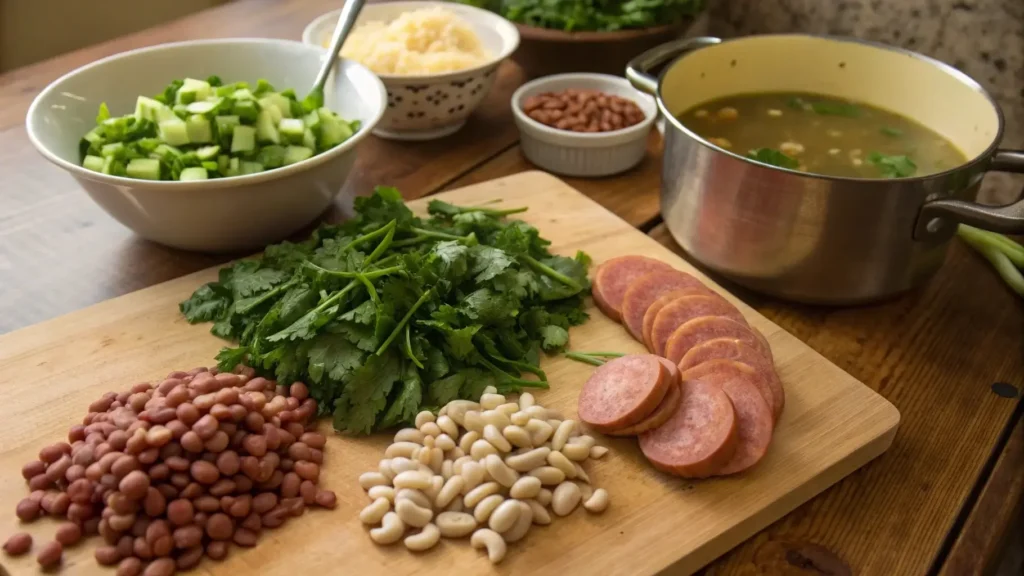
Before you start cooking, make sure everything is ready to go:
✔ Slice the smoked beef sausage into bite-sized rounds.
✔ Chop the onion and garlic finely.
✔ Drain and rinse the beans to remove excess sodium.
✔ Measure out all the seasonings and broth.
Step 2: Sautéing the Aromatics and Meat
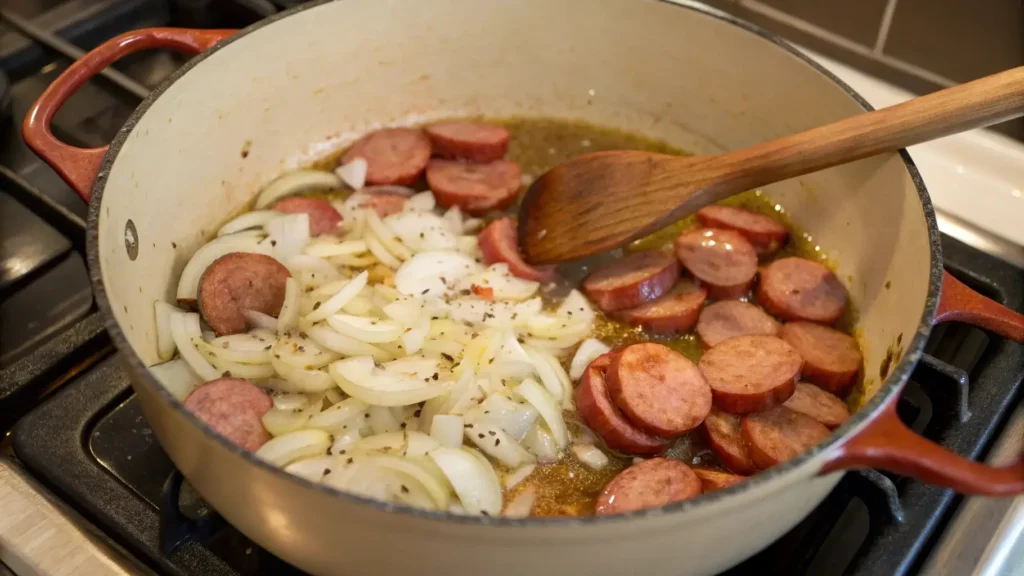
Heat a large pot or Dutch oven over medium heat. Add olive oil and sauté the onion and garlic for about 3 minutes until fragrant. Then, add the sliced sausage and cook until slightly browned. This step helps release all the smoky flavors into the soup.
Step 3: Simmering the Broth and Beans
Once the sausage is browned, pour in the chicken broth, followed by the drained beans and seasonings (salt, pepper, and smoked paprika). Stir well and let the mixture simmer for about 10 minutes to allow the flavors to develop.
Step 4: Adding Greens and Pasta
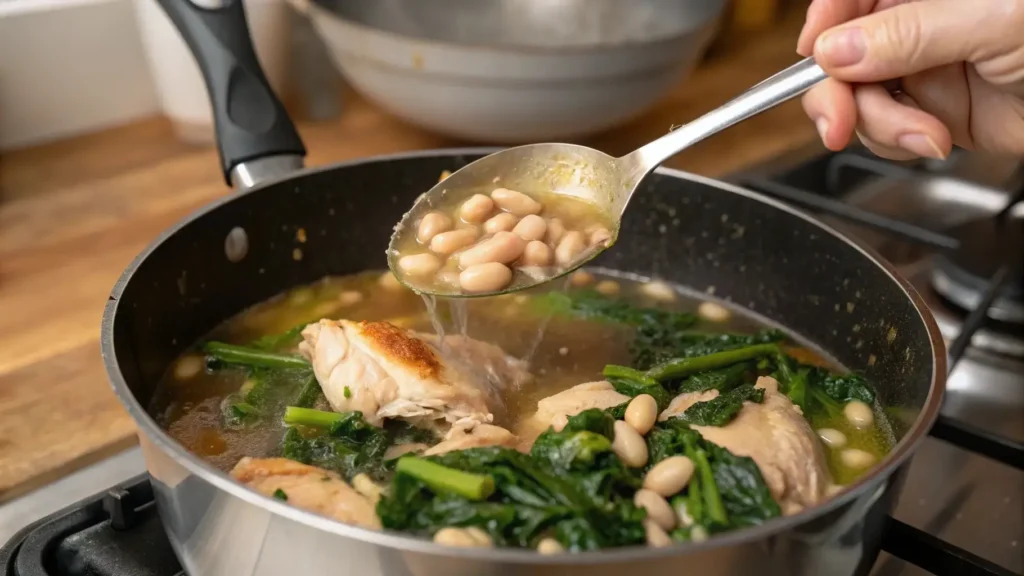
Now, stir in the turnip greens and let them cook down for 5 minutes. If using pasta or rice, add it at this stage and let it cook until tender. The broth will thicken as the starch absorbs the liquid, creating a rich and hearty texture.
Step 5: Final Seasoning and Serving Tips
Once the soup has reached the desired consistency, stir in the apple cider vinegar to brighten the flavors. Taste and adjust seasonings if needed.
Serving Suggestions
Swamp soup is best enjoyed hot, served with:
✔ A slice of crusty bread or cornbread.
✔ A side of steamed rice for extra heartiness.
✔ A sprinkle of grated Parmesan on top for added depth.
With these simple steps, you’ll have a delicious, comforting bowl of swamp soup ready to enjoy!
Variations and Customization Ideas
One of the best things about swamp soup is how flexible it is. You can easily modify the ingredients to suit your dietary preferences, spice tolerance, or available pantry items. Here are some exciting ways to customize your Swamp Soup Recipe Guide to make it your own.
Vegetarian Swamp Soup
If you want to skip the meat while keeping the soup rich and satisfying, try these swaps:
✔ Replace smoked sausage with sautéed mushrooms or grilled tofu for a meaty texture.
✔ Add an extra can of beans (like chickpeas or great northern beans) for more protein.
✔ Use vegetable broth instead of chicken broth for a plant-based option.
✔ Add a dash of liquid smoke to mimic the smoky sausage flavor.
If you enjoy hearty, vegetable-based soups, a vegetarian swamp soup is similar to the classic Olive Garden Minestrone Soup, with beans, pasta, and greens bringing a rich, comforting texture.
Low-Carb or Keto Swamp Soup
For those following a low-carb lifestyle, here’s how to adapt the recipe:
✔ Omit pasta or rice and add more greens for a fiber boost.
✔ Use cauliflower rice instead of traditional rice.
✔ Stick to low-carb beans, such as black soybeans, or use chopped zucchini as a filler.
✔ Increase the protein content by adding shredded chicken or extra sausage.
Spicy Swamp Soup
Love a little heat? Try these additions:
✔ Add diced jalapeños or a teaspoon of red pepper flakes while sautéing the onions.
✔ Stir in a spoonful of hot sauce or a pinch of cayenne pepper for an extra kick.
✔ Use spicy smoked sausage to intensify the flavor.
Creamy Swamp Soup
Want to make your soup even richer? Here’s how:
✔ Blend a portion of the soup and stir it back in for a thicker texture.
✔ Add a splash of coconut milk or a dollop of Greek yogurt for creaminess.
✔ Stir in a bit of shredded cheese (like cheddar or Parmesan) for extra depth.
Swamp soup is meant to be enjoyed the way you like it, so don’t be afraid to experiment. The possibilities are endless!
Expert Tips for Amateur and Advanced Cooks
Mastering any recipe takes practice, and swamp soup is no exception. Whether it’s your first time making it or you want to perfect your technique, these tips will help you make the best version possible.
Tips for Amateur Cooks: Keep It Simple
If you’re new to cooking or trying swamp soup for the first time, follow these beginner-friendly tips:
✔ Use Pre-Cut Ingredients – Save time by using pre-chopped onions, garlic, and greens. This reduces prep work and makes the recipe easier.
✔ Stick to the Recipe First – Before experimenting with flavors, make the classic version to understand the balance of ingredients.
✔ Control the Salt – Since canned beans and broth can be salty, taste as you go. You can always add more salt, but you can’t take it out.
✔ Simmer for the Best Flavor – Let the soup simmer for at least 30 minutes so the ingredients meld together. The longer it cooks, the richer the taste.
✔ Don’t Overcook the Pasta or Rice – Add it toward the end of cooking so it stays firm instead of turning mushy.
Tips for Advanced Cooks: Elevate Your Swamp Soup
If you’re experienced in the kitchen and want to take your swamp soup up a notch, try these pro techniques:
✔ Sear the Sausage First – Browning the sausage before adding broth gives it a deeper, richer flavor. You can even deglaze the pan with a little broth to capture those tasty browned bits.
✔ Layer Your Seasonings – Instead of adding all the spices at once, sprinkle them in stages to build complexity. A small pinch of smoked paprika at the end can make a big difference.
✔ Use Homemade Broth – If you have time, a homemade chicken or vegetable broth will add more depth than store-bought options.
✔ Balance with Acidity – A splash of apple cider vinegar or lemon juice right before serving brightens the flavors and prevents the soup from tasting too heavy.
✔ Finish with Fresh Herbs – A sprinkle of fresh parsley or green onions just before serving adds a pop of freshness and color.
By following these tips, you’ll be able to create a Swamp Soup Recipe Guide that’s both flavorful and well-balanced, no matter your skill level.
Serving Suggestions for the Best Experience
Swamp soup is already delicious on its own, but pairing it with the right side dishes and toppings can elevate it to the next level.
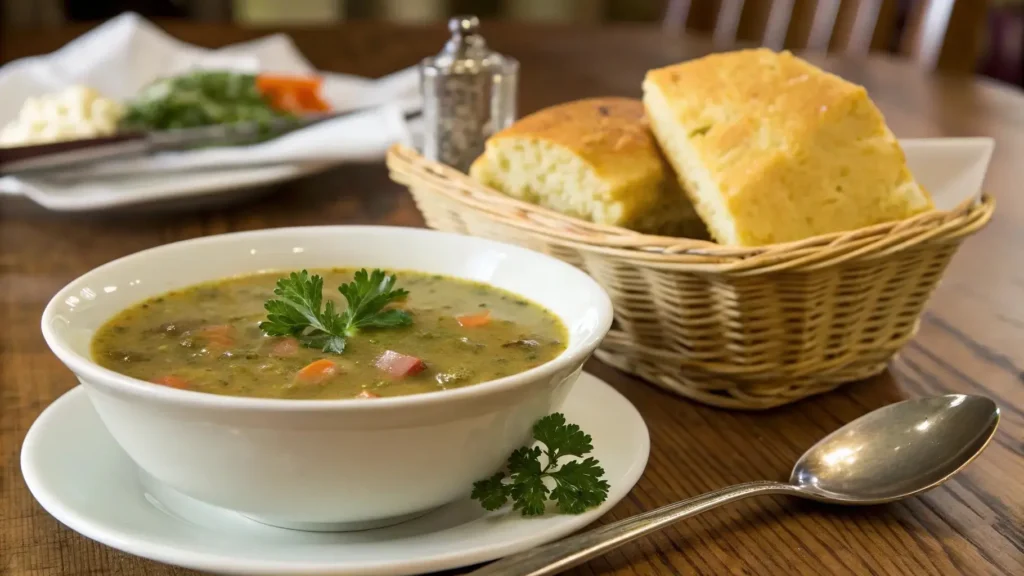
1. Garnishes to Enhance Flavor
A few simple toppings can add texture and extra flavor to your bowl of soup. Here are some tasty options:
✔ Fresh Herbs – Sprinkle chopped parsley or green onions for a fresh touch.
✔ Shredded Cheese – A little grated Parmesan or cheddar adds creaminess.
✔ Crushed Crackers or Croutons – For a crunchy contrast.
✔ A Drizzle of Hot Sauce – If you love a spicy kick.
2. Best Side Dishes to Serve with Swamp Soup
Pairing your swamp soup with the right side dish makes it even more satisfying. Here are some of the best choices:
✔ Cornbread – A classic Southern pairing that balances the smoky flavors of the soup.
✔ Garlic Bread – Perfect for dipping into the rich broth.
✔ Rice or Quinoa – Adds heartiness and makes the meal extra filling.
✔ A Simple Green Salad – For a refreshing contrast to the warm, hearty soup.
3. How to Serve for Different Occasions
Swamp soup is a versatile dish that can be served in different ways depending on the occasion:
✔ Casual Weeknight Dinner – Serve it with bread and a salad for a quick, balanced meal.
✔ Family Gathering – Make a large pot and serve buffet-style with various toppings.
✔ Cold Weather Comfort – Enjoy a steaming bowl by the fireplace with a cozy blanket.
With all these serving ideas, you’re guaranteed to have an incredible experience enjoying your Swamp Soup Recipe Guide. Whether you stick to the classic version or customize it to your liking, this soup is a meal that brings warmth and satisfaction to every bite.
Storage, Reheating, and Meal Prep Tips
Swamp soup is a fantastic meal to make ahead of time because its flavors deepen and improve as it sits. Whether you’re meal prepping for the week or storing leftovers, these tips will help keep your soup fresh and delicious.
How to Store Swamp Soup in the Refrigerator
If you plan to eat your swamp soup within a few days, storing it in the fridge is the best option. Follow these steps:
✔ Allow the soup to cool completely before storing. Placing hot soup in the fridge can create condensation, leading to excess moisture and faster spoilage.
✔ Transfer the soup into an airtight container to prevent it from absorbing other food odors.
✔ Store in the refrigerator for up to 4 days.
Before serving, check the soup for any signs of spoilage, such as an off smell or unusual texture.
Freezing for Long-Term Storage
Swamp soup freezes exceptionally well, making it a perfect meal to have on hand for busy days. Here’s how to freeze it properly:
✔ Portion out the soup into freezer-safe containers or resealable bags. This makes it easy to reheat only what you need.
✔ Leave a little space at the top of the container since liquid expands when frozen.
✔ Label each container with the date so you can track how long it’s been stored.
✔ Swamp soup can be frozen for up to 3 months.
When ready to eat, thaw the soup overnight in the fridge or place the frozen container in a bowl of cold water to speed up the process.
Best Reheating Methods Without Losing Flavor
The key to reheating swamp soup is doing it gently to maintain its texture and taste. Here are the best methods:
✔ On the Stovetop – Pour the soup into a pot and heat over medium-low, stirring occasionally. Add a splash of broth or water if it has thickened too much.
✔ In the Microwave – Place a portion in a microwave-safe bowl and cover loosely. Heat in 1-minute intervals, stirring in between, until fully warmed.
✔ In a Slow Cooker – If you’re reheating a large batch, pour the soup into a slow cooker and heat on low for 1-2 hours.
With these storage and reheating tips, you can enjoy a delicious bowl of swamp soup anytime without compromising its flavor or texture.
Frequently Asked Questions
Many people have questions about making and customizing their swamp soup. Here are the most commonly asked questions, along with helpful answers.
1. Can I use fresh greens instead of canned or frozen?
Absolutely! Fresh greens like turnip greens, collard greens, or kale work great in swamp soup. Just remember to wash them thoroughly and chop them into smaller pieces before adding them to the pot. Since fresh greens take longer to cook than canned or frozen ones, simmer them for at least 10-15 minutes to soften properly.
2. How do I make Swamp Soup less salty?
If your soup turns out too salty, don’t worry—there are easy ways to fix it:
✔ Add extra broth or water to dilute the saltiness.
✔ Stir in a small boiled potato to absorb excess salt, then remove it before serving.
✔ Balance the flavors with a splash of apple cider vinegar for acidity.
3. What are some good protein substitutes for sausage?
If you don’t want to use smoked sausage, try these protein alternatives:
✔ Shredded chicken – Adds a mild, tender texture.
✔ Ground turkey – A leaner option with a hearty taste.
✔ Lentils or chickpeas – A great plant-based protein alternative.
4. Can I cook this soup in a slow cooker or Instant Pot?
Yes! Swamp soup is perfect for both slow cookers and Instant Pots.
✔ Slow Cooker Method – Add all ingredients except pasta and cook on low for 6-8 hours or high for 3-4 hours. Stir in the pasta during the last 30 minutes.
✔ Instant Pot Method – Use the sauté function to cook the onions, garlic, and sausage. Add the remaining ingredients, except pasta, and pressure cook on high for 10 minutes. Quick-release the pressure, stir in the pasta, and let it sit for a few minutes until tender.
Final Thoughts
Swamp soup is more than just a recipe—it’s a warm, comforting dish that brings together rich flavors and hearty ingredients. Whether you’re cooking it for the first time or perfecting your technique, this Swamp Soup Recipe Guide ensures that every bowl you make is delicious and satisfying.
Now, it’s time to grab your pot, gather your ingredients, and start cooking! Enjoy your swamp soup, and don’t forget to share it with family and friends.
